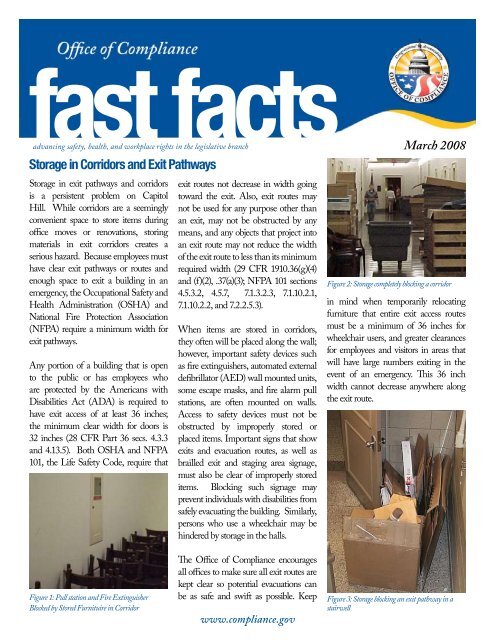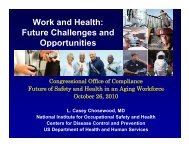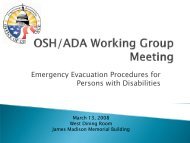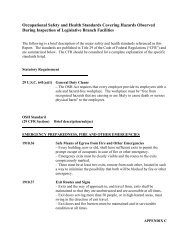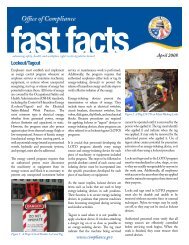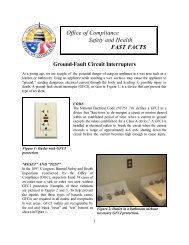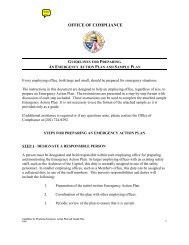Storage in Corridors and Exit Pathways - Office of Compliance
Storage in Corridors and Exit Pathways - Office of Compliance
Storage in Corridors and Exit Pathways - Office of Compliance
Create successful ePaper yourself
Turn your PDF publications into a flip-book with our unique Google optimized e-Paper software.
fast facts<br />
advanc<strong>in</strong>g safety, health, <strong>and</strong> workplace rights <strong>in</strong> the legislative branch March 2008<br />
<strong>Storage</strong> <strong>in</strong> <strong>Corridors</strong> <strong>and</strong> <strong>Exit</strong> <strong>Pathways</strong><br />
<strong>Storage</strong> <strong>in</strong> exit pathways <strong>and</strong> corridors<br />
is a persistent problem on Capitol<br />
Hill. While corridors are a seem<strong>in</strong>gly<br />
convenient space to store items dur<strong>in</strong>g<br />
<strong>of</strong>fice moves or renovations, stor<strong>in</strong>g<br />
materials <strong>in</strong> exit corridors creates a<br />
serious hazard. Because employees must<br />
have clear exit pathways or routes <strong>and</strong><br />
enough space to exit a build<strong>in</strong>g <strong>in</strong> an<br />
emergency, the Occupational Safety <strong>and</strong><br />
Health Adm<strong>in</strong>istration (OSHA) <strong>and</strong><br />
National Fire Protection Association<br />
(NFPA) require a m<strong>in</strong>imum width for<br />
exit pathways.<br />
Any portion <strong>of</strong> a build<strong>in</strong>g that is open<br />
to the public or has employees who<br />
are protected by the Americans with<br />
Disabilities Act (ADA) is required to<br />
have exit access <strong>of</strong> at least 36 <strong>in</strong>ches;<br />
the m<strong>in</strong>imum clear width for doors is<br />
32 <strong>in</strong>ches (28 CFR Part 36 secs. 4.3.3<br />
<strong>and</strong> 4.13.5). Both OSHA <strong>and</strong> NFPA<br />
101, the Life Safety Code, require that<br />
Figure 1: Pull station <strong>and</strong> Fire Ext<strong>in</strong>guisher<br />
Blocked by Stored Furnituire <strong>in</strong> Corridor<br />
exit routes not decrease <strong>in</strong> width go<strong>in</strong>g<br />
toward the exit. Also, exit routes may<br />
not be used for any purpose other than<br />
an exit, may not be obstructed by any<br />
means, <strong>and</strong> any objects that project <strong>in</strong>to<br />
an exit route may not reduce the width<br />
<strong>of</strong> the exit route to less than its m<strong>in</strong>imum<br />
required width (29 CFR 1910.36(g)(4)<br />
<strong>and</strong> (f)(2), .37(a)(3); NFPA 101 sections<br />
4.5.3.2, 4.5.7, 7.1.3.2.3, 7.1.10.2.1,<br />
7.1.10.2.2, <strong>and</strong> 7.2.2.5.3).<br />
When items are stored <strong>in</strong> corridors,<br />
they <strong>of</strong>ten will be placed along the wall;<br />
however, important safety devices such<br />
as fire ext<strong>in</strong>guishers, automated external<br />
defibrillator (AED) wall mounted units,<br />
some escape masks, <strong>and</strong> fire alarm pull<br />
stations, are <strong>of</strong>ten mounted on walls.<br />
Access to safety devices must not be<br />
obstructed by improperly stored or<br />
placed items. Important signs that show<br />
exits <strong>and</strong> evacuation routes, as well as<br />
brailled exit <strong>and</strong> stag<strong>in</strong>g area signage,<br />
must also be clear <strong>of</strong> improperly stored<br />
items. Block<strong>in</strong>g such signage may<br />
prevent <strong>in</strong>dividuals with disabilities from<br />
safely evacuat<strong>in</strong>g the build<strong>in</strong>g. Similarly,<br />
persons who use a wheelchair may be<br />
h<strong>in</strong>dered by storage <strong>in</strong> the halls.<br />
The <strong>Office</strong> <strong>of</strong> <strong>Compliance</strong> encourages<br />
all <strong>of</strong>fices to make sure all exit routes are<br />
kept clear so potential evacuations can<br />
be as safe <strong>and</strong> swift as possible. Keep<br />
www.compliance.gov<br />
Figure 2: <strong>Storage</strong> completely block<strong>in</strong>g a corridor<br />
<strong>in</strong> m<strong>in</strong>d when temporarily relocat<strong>in</strong>g<br />
furniture that entire exit access routes<br />
must be a m<strong>in</strong>imum <strong>of</strong> 36 <strong>in</strong>ches for<br />
wheelchair users, <strong>and</strong> greater clearances<br />
for employees <strong>and</strong> visitors <strong>in</strong> areas that<br />
will have large numbers exit<strong>in</strong>g <strong>in</strong> the<br />
event <strong>of</strong> an emergency. This 36 <strong>in</strong>ch<br />
width cannot decrease anywhere along<br />
the exit route.<br />
Figure 3: <strong>Storage</strong> block<strong>in</strong>g an exit pathway <strong>in</strong> a<br />
stairwell
Figure 4: Even temporary storage is considered a potential hazard<br />
St<strong>and</strong>ards to reference:<br />
• 28 CFR Part 36 sections 4.3.3 <strong>and</strong> 4.13.5<br />
• 29 CFR 1910.36(g)(4) <strong>and</strong> (f)(2), .37(a)(3)<br />
fast stats<br />
• NFPA 101 sections 4.5.3.2, 4.5.7, 7.1.3.2.3, 7.1.10.2.1, 7.1.10.2.2, <strong>and</strong> 7.2.2.5.3<br />
Items that should never be blocked <strong>in</strong>clude:<br />
• Fire ext<strong>in</strong>guishers<br />
• Automated External Defibrillator (AED)<br />
• Escape masks<br />
• Fire alarm pull stations<br />
• Wall-mounted firefighter phones<br />
• Wall-mounted floor plans with exit routes, nearest exit, or Americans with Disabilities Act (ADA)<br />
exit<strong>in</strong>g <strong>in</strong>formation<br />
• Room identification signs<br />
• ADA emergency stag<strong>in</strong>g area <strong>and</strong> stag<strong>in</strong>g area signs<br />
• Brailled exit <strong>in</strong>formation signage<br />
• Brailled signage <strong>in</strong> exit stairwells <strong>and</strong> at all build<strong>in</strong>g exits.<br />
• Electrical panelboards with circuit breakers <strong>in</strong>side.<br />
Peter Ames Eveleth<br />
General Counsel<br />
Rachel Berg Scherer<br />
Editor<br />
If you spot a safety hazard <strong>in</strong> your legislative branch<br />
workplace, contact the <strong>Office</strong> <strong>of</strong> <strong>Compliance</strong> to report it:<br />
Room LA 200, John Adams Build<strong>in</strong>g<br />
110 Second Street, SE<br />
Wash<strong>in</strong>gton, DC 20540<br />
t/ 202-724-9250; tdd/ 202-426-1912; f/ 202-426-1913<br />
Recorded Information L<strong>in</strong>e/ 202-724-9260<br />
www.compliance.gov<br />
The <strong>Office</strong> <strong>of</strong> <strong>Compliance</strong> advances safety, health,<br />
<strong>and</strong> workplace rights <strong>in</strong> the U.S. Congress <strong>and</strong> the<br />
Legislative Branch. Established as an <strong>in</strong>dependent<br />
agency by the Congressional Accountability Act <strong>of</strong><br />
1995, the <strong>Office</strong> educates employees <strong>and</strong> employ<strong>in</strong>g<br />
<strong>of</strong>fices about their rights <strong>and</strong> responsibilities under the<br />
Act, provides an impartial dispute resolution process,<br />
<strong>and</strong> <strong>in</strong>vestigates <strong>and</strong> remedies violations <strong>of</strong> the Act.<br />
This <strong>in</strong>formation does not constitute advice or an <strong>of</strong>ficial rul<strong>in</strong>g <strong>of</strong> the <strong>Office</strong> <strong>of</strong> <strong>Compliance</strong> or the Board <strong>of</strong> Directors <strong>and</strong> is <strong>in</strong>tended for educational<br />
purposes only. For further <strong>in</strong>formation, please refer to the Congressional Accountability Act (2 U.S.C 1301 et seq.) <strong>and</strong> the regulations issued by the<br />
Board, or you may contact the <strong>Office</strong> <strong>of</strong> <strong>Compliance</strong>.


